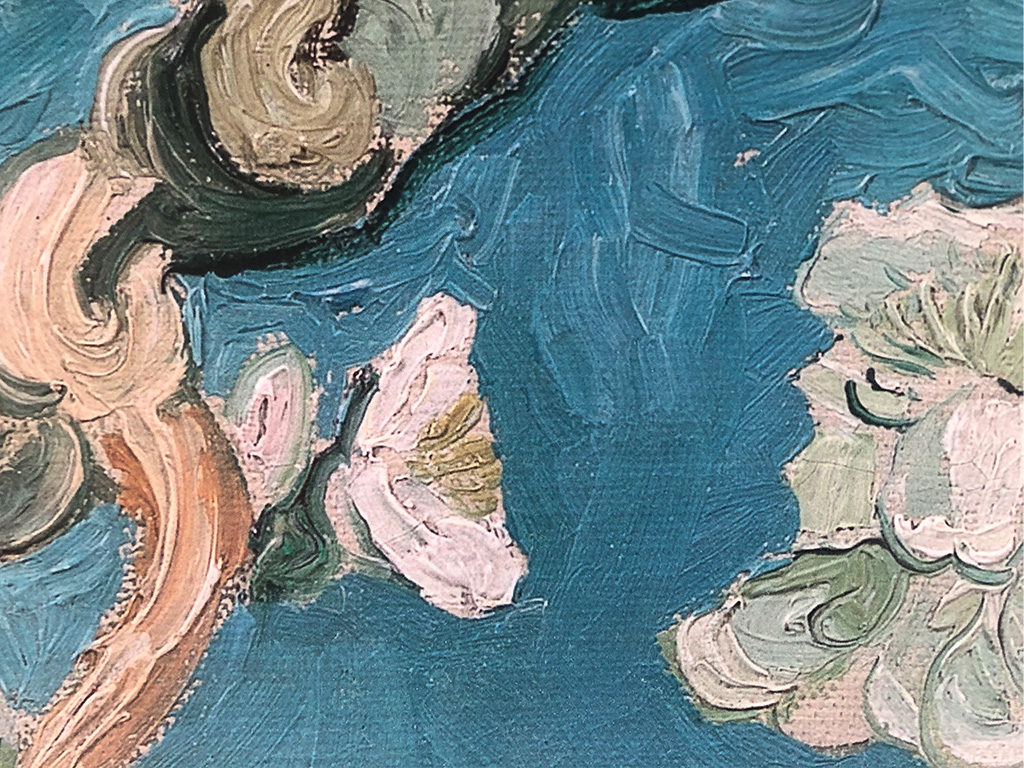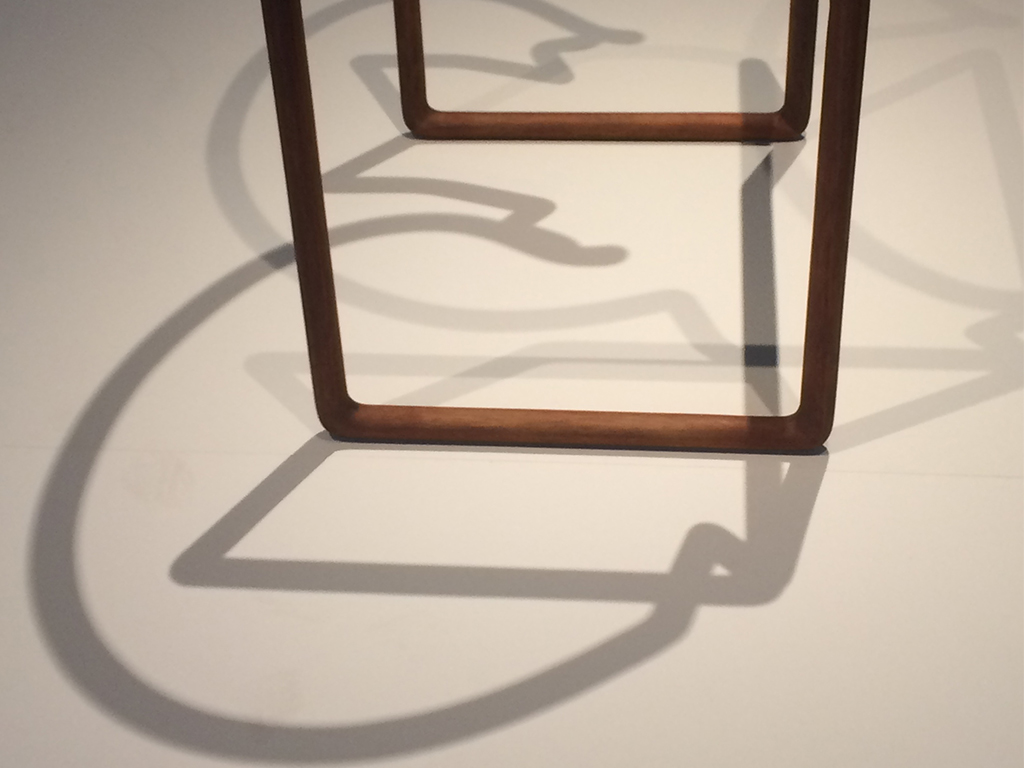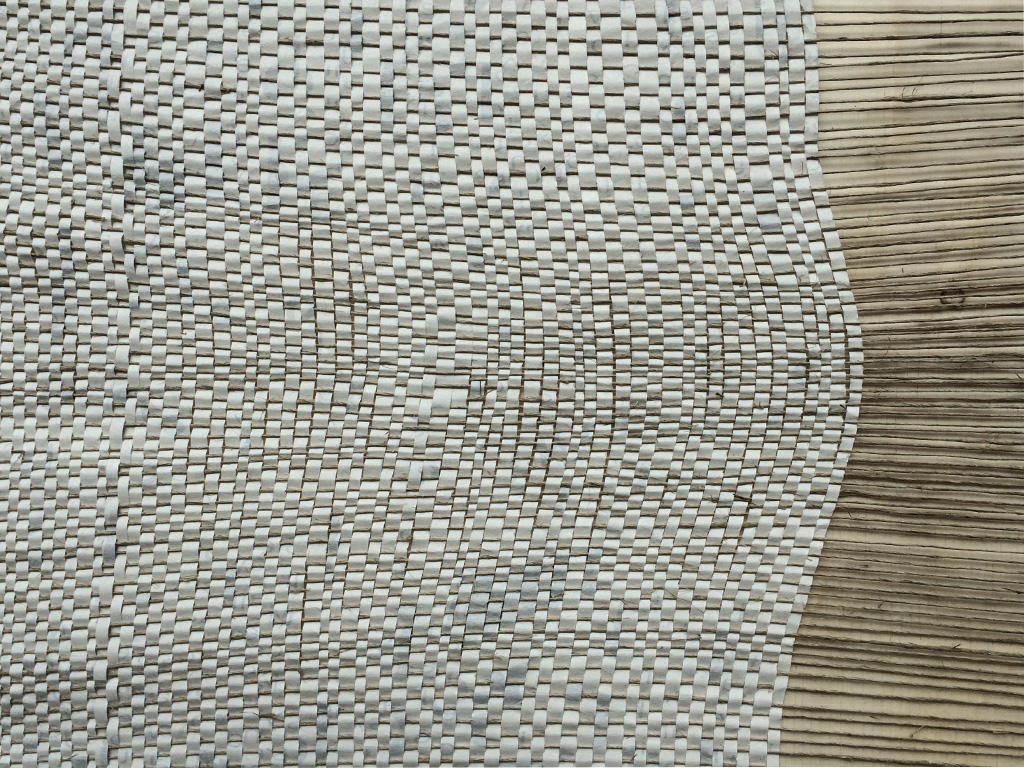
How Art can make us slow down by
Goedele Wellens
Slowing down by looking at Art
We are living in a quickly evolving society in which people are looking for ways to evade the velocity in which this is being executed. We want to avoid stress and the agitation in which this is happening. Pressure already starts in the first years you go to school, and you are being tested and evaluated. Is there still time to play, experience and explore? As a child this is so much easier than when adult. As soon as you have chosen your direction there is no time to be lost or idle, you have to move on. The consequence is that people get stuck in a rigid thinking pattern.
During the Master in Arts Education I conducted research on how art can contribute in becoming aware of your own judgment (or prejudices). By looking at art together and sharing your observations and interpretations during a dialogue you become aware of your own assumptions.
By conducting this conversation people become aware of their own prejudices and that of others. While looking at art you can train yourself taking time to study the details in a work of art. Looking attentively makes you be in the here and now. You slow down and you start to question your own reality.
Wieteke van Zeil points out in her book, Altijd iets te vinden (2020), how you can learn to postpone your opinion by looking at art. Of course, you can’t reduce stress just by postponing an opinion, however I do see a connection. Van Zeil makes a comparison with social media, how these forces you to make quick judgments. However due to the speed, context and how nuances are being covered up it gets harder to make a good judgement (2020, p.10). I think that with the speed in which expectations are being cultivated in for example college or in the business world you deny yourself time and space to reflect on your work and your own strength.
The method I want to use is Visual Thinking Strategies (VTS). Looking at art via this method doesn’t require foreknowledge about the work of art. You do not need to know anything about the intentions of the artist, you look, interpret and share your findings with the group. How you feel and your emotions determine what we see, and so how we judge. You interpret your observations from these feelings (Van Zeil, 2020, p.15-16). To become aware of your own assumptions and thought patterns it is important to share your thoughts with others.
Art can at times give you the freedom to get to thoughts where you before could not – yet - get to (Van Zeil, 2020, p. 34). If you restrict your observation to your own personal interpretation you can miss things. We see what we want to see. Another person interprets and looks differently or is aware of other details (Herman, 2016). By opening up the conversation you can open up to the other person. The conversation could take place in a formal or informal setting. The space has influence on your sense of security. We believe that the intervention Emi will design could also influence our interpretation.
According to Herman (2016, p.149) observations are being made by all senses. When we place ourselves around a table we have to relate to each other one way or another. This is a thought Hannah Arendt formulated as follows (translated from Dutch); “everybody is unique in its own way, everybody experiences life from another perspective and that’s why we have something to offer to each other if we know how to convert these experiences in ideas and pass these on to others” (Dewey, 2011, p.184).
By looking at art for a substantial time we become aware of our presuppositions of reality. We try to clarify the concept and look for confirmation or we try to change and alter our reality. Art teaches us how to look and take perspective. By looking we can search the boundaries of our social concepts. We will be challenged to open our eyes, discover rigid patterns and open up to unknown territory. By looking at art we can stretch our thinking and make it more flexible. By looking together and talking about what you see you will be made aware of that flexibility.
From you own position (your norms, values, culture) you relate to someone else and you communicate with each other to get nearer to each other. At a table you can share stories, but also food. Eating is next to looking at art or sharing a space, a way of sharing your stories. Does eating together also influence our perception of time?
From my expertise as an arts educator I think art can help interpret and understand internal processes better. To test this we, Antoon Wellens and Emi Tsutsushio will work together. An interdisciplinary cooperation in which we want to research if this assumption is correct. A source of inspiration for this experiment is the term ‘eatscape’. This concept is derived from the thesis by Chotima Ag-ukrikul, Let’s Eat Together. Methods and Tools for Inclusive City Design Practice:
“Eatscape is a construction of eat and landscape, and defined here as a fluid landscape which is shaped by people and their performance in shared physical and social settings while the practice of commensality occurs.”
(Ag-ukrikul, 2019, p.3)
How can social aspects, action and interaction between people, and spatial aspects like form and material (Ag-ukrikul, 2019, p.2) be of influence on our experience of time. In short, we want to research how looking, smelling, tasting and experiencing can influence our mental wellbeing.
Bibliography:
- Ag-ukrikul, C. (2019, oktober). Let’s Eat Together Methods and Tools for Inclusive City Design Practice. Chalmers, Architecture and Civil Engineering, Building Design. https://research.chalmers.se/en/publication/513239
- Biesta, G. (2015). Het prachtige risico van onderwijs (4e ed.). Culemborg: Phronese.
- Dewey, J., & Berding, J. W. A. (2011). John Dewey over opvoeding, onderwijs en burgerschap: een keuze uit zijn werk. Amsterdam: SWP.
- Herman, A. E. (2016). De kunst van het observeren (1ste editie). Amsterdam: Atlas Contact, Uitgeverij.
- van Zeil, W. (2020). Altijd iets te vinden (1ste editie). Atlas Contact.

Psychological flexibility by Antoon Wellens
Psychological flexibility
“Systems that are able to move toward maximal complexity are healthy systems. They are the most stable, adaptive, and flexible. What a wonderfully concise definition of well-being!”
(Solomon & Siegel, 2003, p.3)
Psychological flexibility and having a meaningful life means you can give yourself space to choose your behavior. You will not be led by feelings or thoughts, however you consciously choose a direction which is valuable. This means you can take perspective, you are able to perceive what works or actually works against you. What rules you impose yourself or were imposed on you help or impede? You have a choice if you want to listen to these rules, however you first have to see them. These norms (from the past) are in itself not wrong, they helped you, however do they still help you in what you find important now?
When you can take a perspective, when being attentive in the moment, it’s important to investigate your inner curiosity. That is, don’t avoid annoying feelings or thoughts, but accept these. Accepting is an activity, it is opening yourself up. This asks for a certain willingness, to be open for things that occur. By investigating this, the structures you’ve made yourself are exposed, and the interaction between you and the world will become apparent. It becomes clear how you and your social environment (friends, family, culture, society) can give stability to function better. Being attentive, to take perspective and opening yourself up is not for the sake of being open, but for the action, for ‘doing’. Does the present structure bring you closer to what you or we want to achieve?
The next question which comes into view is to ask yourself what you find important and valuable to take the next steps into that direction. Out of our comfort zone, of the known territory, and to set out on an adventure into the unknown. Do what you find important, with all insecurities that comes with it. We learn that we need to be positive and happy, however these are only labels and concepts. Without resistance there’s no fear or happiness. We do not only need to do what feels good, but we have to act on what we find desirable and what justifiably can be desired (Biesta, 2015, p.18).
By approaching the world from different truths, realities or perspectives you can research how to handle. This approach is functional, what works and what doesn’t.
Sometimes we are consciously blind to things, because we don’t dare or want to face them. You need to learn to alter your viewpoint. If you simplify the complexity of what you see or you only want to look at it from one point of view, you deny yourself the opportunity to broaden your viewpoint. There are always more elements in play. To face your blind spots, you need to have courage, take responsibility, make yourself vulnerable. How you deal with a situation is a choice. And for that we need to take responsibility.
That’s why attention is important, what happens in this situation, how do I react? What values and principles determine this choice and how do I act on it? To take responsibility is the skill to react. How do we keep things workable together? To keep the conversation going together. By learning the skill to listen to each other and take responsibility to listen.
You can learn this skill by slowing down by looking at art. Through looking at art we can discuss the complexity of the world through dialogue. By sharing this experience and by sharing a meal on the same table in a shared safe space we can be made aware of our different views on the world.
Bibliography:
- Biesta, G. (2015). Het prachtige risico van
onderwijs (4e ed.). Culemborg: Phronese.
- Hayes, S. C., & Smith, S. (2005). Get out of your mind & into your life: The new acceptance & commitment therapy. New Harbinger Publ.
- Jansen, G., & Batink, T. (2017). Time to ACT!: Het basisboek voor professionals. Thema.
- Pollan, M. (2013). Cooked: A Natural History of Transformation. The Penguin Press HC.
- Solomon, M. F., & Siegel, D. J. (2003). Healing trauma: Attachment, mind, body, and brain [Kindle Windows Version]. Retrieved from Amazon.nl

Weaving as metaphor by Emi Tsutsushio
Weaving as metaphor
Weaving is the craft or action of forming fabric by interlacing threads. The craft of weaving is used as a metaphor not only in the field of textile as a philosophical understanding of our world, but also in architecture and urbanism.
Weaving is also a medium for community art. In the installation created by the collective Matri-Archi(tecture)’s “Weaving Constellations of Identity” (2021) at Vitra Museum, the final art piece is created in collaboration with a female weaving community in Basel.

“In our work as a collective, we call for inclusion of marginalised identities. How design is understood and interpreted is always determined from the cultural context from which it emerges.”
“The work invites the visitor to consider the emotional journey of following your professional calling to Design. We have recorded five African designers who were asked to reflect on their professional lives, the forces that drove them, the obstacles they faced and the lessons they learned. Their trajectories are visualised in the exhibited art piece, which was finalized in a collaboration with a female weaving community in Basel.”
– Khensani de Klerk and Solange Mbanefo, the co-directors of the collective Matri-Archi(tecture), are committed to increasing the visibility and recognition of African and Black women’s work in architecture, design, and spatial education.
Scaling the weaving onto an exsisting building, Nicolas K. Feldmeyer created a site-specific installation in which he has woven the columns of the portico of the central building at the University College London. The interwoven mesh sheets bring lightness to the massive pillars, presenting a new temporary monumentality to the building.

PVC mesh, webing, ratchets 24x8x3m
Nicolas K. Feldmeyer, untitled (woven portico) © photo Nick Rochowski
Weaving with paper and slowing down the design process
How does weaving as a metaphor relate in creating the space for slowing down? Using my hands, I started to weave my own fabric with washi paper and thin hemp ropes. I began with the simple movement of going above and below the warp threads. After twenty rows or so, the weaving in the middle becomes more tightly binded together that it is difficult to weave. Further on, the pattern comes to resemble a gently undulating hill. The ends loosens up more and more. I can see the tention gathered in the center.

©photo STUDIO EMIT
Weaving is therapeutic in the sense that the structural rhythm gives routine and stability to the action. Calmness of knowing what you are doing gives time for reflections in your busy mind.
As I weave further, I encounter unexpectedness even in the ordered way of weaving. Like the tension creating gradual change in the shape of the woven object.
Under the topic of ‘Searching for Atmosphere: Uncertainty and Slowness’, Juhani Pallasmaa writes that unexpectedness is a gift, to experience this unexpectedness, the design process needs to slow down.
“It is quite clear that the best things in life have always been gifts. These things that are against your deliverate plans become the most fortunate things. Usually when you go in search os some specific information you don’t find what you were looking for. But when you open the next book, it is that unexpected one that trigger’s you. This is part of the essence of uncertainty. The search itself is important, as well as the vividness of that search.”
“Therefor I think the design process should slow down, to condense thought and feeling, and to increase the possibility to be surprised. When you design with a pencil, instead of doing it quickly with the computer, the process is significiantly slower. It is the time span that allows one to think about a ot of things stimultaneiosly - and all of it is relevant.”
Weaving as a metaphor, using your own hands and weaving manually gives you the time to relect your thoughts that lingers in your mind. Making with your own hands is the act of embodying slowness. The physical result of the woven piece of fabric brings unexpected insights which otherwise, would have been left unnoticed.
References:
- Matri-Archi(tecture), “Weaving Constellations of Identity” (2021) at Vitra Museum
- Nicolas K. Feldmeyer, untitled (woven portico)
- OASE #91, Building Atmpsphere © nai010 Publishers, Rotterdam, 2013, Atmosphere, Compassion and Embodied ExperienceA conversation about Atmosphere with Juhani Pallasmaa

Practicing the delay in action by Goedele Wellens
Practicing the delay in action
On one of the first beautiful Saturdays in spring, we are invited to join a Japanese tea ceremony. We do not have to travel to Japan but are invited by tea master Michel Decré in Eindhoven. He will give us an impression of what is involved in a tea ceremony, without the long sitting in the seiza position. In a traditional ceremony, it can take up to three hours before finishing a ceremony and it is difficult for our stiff muscles to keep this up.
During this short ceremony, we experience the importance of the rituals involved in drinking tea together. The peace of the Japanese garden, the welcome by pouring water on the stones and pebbles and the calmness that Michel radiates also makes us calm, but also wondering. We crawl into the teahouse through a low, small door. We sit down on the tatami mat and wait for what is to come. You don't know whether you are doing the right thing and we are always waiting for instructions as to what actions we should be taking. The small room is divided into areas by the tatami mats, the ceiling is quite low, and the room is almost empty. Apart from the 'altar' with a calligraphy in Japanese characters and a vase with flowers which forms the biggest contrast with the rest of the room, the room radiates tranquility. During the preparation of the tea, it is quiet, apart from the sounds of the bamboo cup with which the water is poured from the kettle into the bowl and the beating of the matcha tea. Everything radiates peace and harmony, with your senses focusing on what is happening at that moment, the sounds, the smells, the picking up of the tea bowl and the tasting of the tea in combination with the sweetness. The ceremony proved to be a beautiful and rich source of inspiration for our project Space for Slowing Down.
References :
- cover photo
©Tokyo Metropolitan Teien Art Museum,
"Kōka" teahouse in the garden of the Tokyo Metropolitan Teien Art Museum, https://www.instagram.com/p/CZi1lN7Leus/ -
Film of "Kōka" teahouse ©Tokyo Metropolitan Teien Art Museum